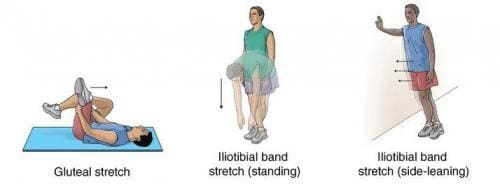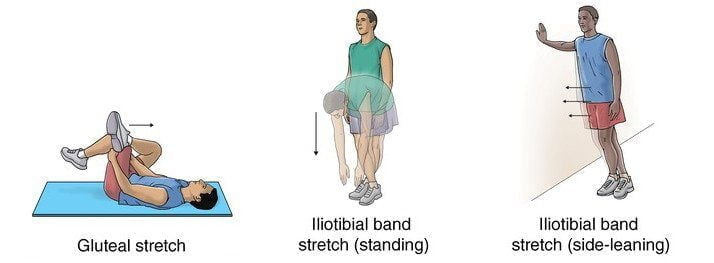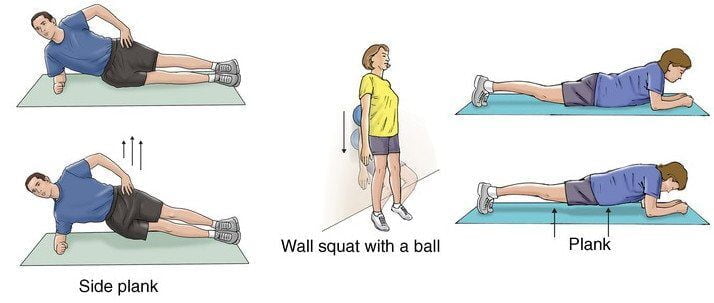
Best Hip Pain Exercises for Trochanteric Bursitis
Maintaining strength and flexibility in hip muscles through hip pain exercise reduces the friction that causes Trochanteric Bursitis. Trochanteric Bursitis is caused by the inflammation of your bursa, a jelly-like, fluid-filled sac that reduces friction between moving tissues in your body. Inflammation can cause stiffness and pain, making it difficult to sit, walk, stand or sleep.
Start each exercise slowly, and ease off the exercise if you start having pain. You can do the first 3 stretches to begin stretching the muscles that run along the outside of your hip, continue with the strengthening hip pain exercises when the sharp pain lessens.
Hip Pain Exercise Stretches
Gluteal stretch
Lie on your back with both knees bent. Rest the ankle on your injured side over the knee of your other leg. Grasp the thigh of the leg on the uninjured side and pull toward your chest. You will feel a stretch along the buttocks on the injured side and possibly along the outside of your hip. Hold the stretch for 15 to 30 seconds. Repeat 3 times.

Iliotibial band stretch, standing
Cross your uninjured leg in front of the other leg and bend down and reach toward the inside of your back foot. Do not bend your knees. Hold this position for 15 to 30 seconds. Return to the starting position. Repeat 3 times.
Iliotibial band stretch, side-leaning
Stand sideways near a wall with your injured side closest to the wall. Place a hand on the wall for support. Cross the leg farther from the wall over the other leg. Keep the foot closest to the wall flat on the floor. Lean your hips into the wall. Hold the stretch for 15 to 30 seconds. Repeat 3 times.
Strengthening Exercises (Hip Pain)

Side plank
Lie on your side with your legs, hips, and shoulders in a straight line. Prop yourself up onto your forearm with your elbow directly under your shoulder. Lift your hips off the floor and balance on your forearm and the outside of your foot. Try to hold this position for 15 seconds and then slowly lower your hip to the ground. Switch sides and repeat. Work up to holding for 1 minute. This hip pain exercise can be made easier by starting with your knees and hips flexed toward your chest.
Wall squat with a ball
Stand with your back, shoulders, and head against a wall. Look straight ahead. Keep your shoulders relaxed and your feet 3 feet (90 centimetres) from the wall and shoulder’s width apart. Place a soccer or basketball-sized ball behind your back. Keeping your back against the wall, slowly squat down to a 45-degree angle. Your thighs will not yet be parallel to the floor. Hold this position for 10 seconds and then slowly slide back up the wall. Repeat 10 times. Build up to 2 sets of 15.
The plank
Lie on your stomach resting on your forearms. With your legs straight, lift your hips off the floor until they are in line with your shoulders. Support yourself on your forearms and toes. Hold this position for 15 seconds. (If this is too difficult, you can modify it by placing your knees on the floor.) Repeat 3 times. Work up to increasing your hold time to 30 to 60 seconds.

Side-lying leg lift
Lie on your uninjured side. Tighten the front thigh muscles on your injured leg and lift that leg 8 to 10 inches (20 to 25 centimetres) away from the other leg. Keep the leg straight and lower it slowly. Do 2 sets of 15.
Clam Hip Pain exercise
Lie on your uninjured side with your hips and knees bent and feet together. Slowly raise your top leg toward the ceiling while keeping your heels touching each other. Hold for 2 seconds and lower slowly. Do 2 sets of 15 repetitions.
Experiencing foot and ankle pain? Click here to find out more about physiotherapy for foot and ankle pain relief and how Core Concepts Singapore can effectively manage ankle, foot, knee, hip pain Physiotherapy.
Related Articles
- Trochanteric Bursitis Trochanteric bursitis is a common hip syndrome that causes pain and tenderness at the bony, outside point of the hip.…
- Retrocalcaneal Bursitis: When Is Achilles Tendinitis… Do you experience pain at the back of your heel? Is the back of your heel red and swollen?…
- HIIT Workouts: Check Your Form (Upper & Lower Body) High-Intensity Interval Training (HIIT) is an increasingly popular and effective way to get lean. HIIT Programmes strip away the…
- Unlock Your Running Potential with 5 Essential… Running, a sport of endurance and passion, demands more than just putting one foot in front of the other. About…
- Kneeling Pain: What can I do about it? Kneeling can be painful with existing knee pain. As a country often described as having a melting pot of cultures,…
